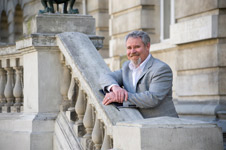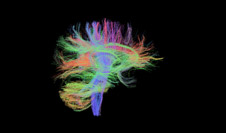The University of Otago's growing ability to be a truly global citizen is the result of advances in IT. In the second of a three-part series, the Otago Bulletin Board talks to ITS about the difference these advances are making to Otago's research output.

Otago keyboards are connecting with the world more than ever.
Otago researchers have joined the global ultra-speed superhighway, and can transfer data 15 times faster – in enormous chunks – to stay at the forefront of their fields.
The cutting-edge advances were sparked by researchers' needs, and are thanks to a potent mix of exploring new frontiers and collaboration.

Professor Richie Poulton.
The world-renowned Dunedin Multidisciplinary Health & Development Study Research Unit wanted people's MRI scan images analysed at Duke University in the United States but discovered no existing commercial providers could send them there easily from Dunedin.
Unit Director Professor Richie Poulton says staff had been dreaming for more than a decade of including scans in the study of 1000 New Zealanders followed since their births more than 40 years ago, to help understand how a brain's structure and function could reflect a person's experiences and predict their mental health.
Hard drive to free flow
University Information Technology Services (ITS) Systems Services Manager and New Zealand eScience Infrastructure Site Manager David Maclaurin was determined his team would help realise that dream because “research is very near to my heart, and it's what makes a University special”.
But Otago's network had not been keeping pace with the massive amount of research data the University was generating, so researchers were downloading data onto external hard drives then couriering them to the data's destination because that was quicker than using the network.
To create a faster network, the ITS team started doing its own research and discovered a combination of hardware and software called a Science DMZ that is specifically designed to let large amounts of research data flow in and out of a network with the least obstructions possible, at the highest speeds possible.
Concierge services
To build a Science DMZ, the ITS team sought help from Research and Education Advanced Network New Zealand (REANNZ), to make sure authorised research data could bypass any security checks it did not need.
REANNZ says the Science DMZ has created security similar to the type concierges provide for an office building: “They've seen you before and they know to let you in … we think of them as on-ramps to the superhighway.”
A driving force

An image of an MRI diffusion scan, of connecting axon pathways, which can travel around on the world now the University is on the ultra-fast data superhighway.
But the University still needed an “engine” to propel the large data sets on to the global superhighway at continuously high speeds, so ITS collaborated with another national organisation, the New Zealand eScience Infrastructure (NeSI), Mr Maclaurin says.
Together they used Globus-based software – never combined with Science DMZ in New Zealand before – to hurl huge volumes of data down the superhighway in one go.
Now, images direct from an MRI scanner in Dunedin, can reach a research lab in the United States in well under three minutes if needed.
So, being a research-intensive University in one of the most southern locations in the world is no longer a problem.
Relationships vital
Help from both NeSI and REANNZ has been vital, Mr Maclaurin says.
“Both these organisations are pushing the boundaries and know about the technology all around the world and they're sowing the seeds and people like us are running with it – it's fun and very rewarding.”
More information can be found here.
Yesterday the Otago Bulletin Board looked at the advancing IT technologies at Otago. Tomorrow it will explore Otago's IT storage solutions.